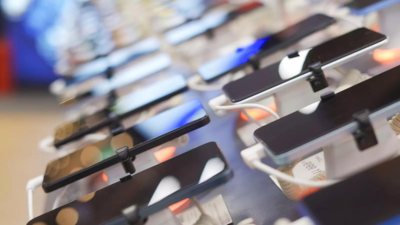
NEW DELHI: US President Donald Trump’s tariff announcements may end up giving India a larger share in global smartphone production from Apple and Samsung, though a more clearer picture will emerge once US concludes its negotiations with various countries to fix final rates.
There is still a chance that countries like Saudi Arabia, UAE and Brazil, which are in 10% tariff bracket – may emerge as ‘new competing manufacturing destinations’ as American electronics makers venture into low-duty locations to keep their costs and prices low to protect consumption.
Apple, which nearly dominates India’s smartphone shipments of roughly $9 billion to the US, will find expansion in India more attractive, considering tariff on New Delhi stands at 27%, compared to peak duty of 54% on China. Apple primarily makes iPhones in India and China.
Through Foxconn and Tata group, Apple has been expanding in India as part of the ‘China+1 strategy’ and India also enjoys an advantage in starting negotiations for a bilateral trade agreement (BTA) with the US. The Indian negotiators and the electronics industry is hoping that New Delhi will be able to manage to get lower tariffs from the US during BTA talks, especially when it comes to exports of value-added products, such as smartphones, as govt positions itself as a ‘trusted manufacturing ally’ for the US.
“Also, support from corporations, such as Apple, Microsoft and Google, may be sought as they may be roped in as key partners to reinforce India’s pitch during BTA negotiations with Trump administration,” a key industry official told TOI.
Electronics industry fears that if tariffs on India continue to remain at 27% for smartphones and other allied products then there is a “chance that companies start setting up new manufacturing units” in countries with lower tariffs.
“The shift to low tariff countries may happen to arrest impact of high manufacturing costs, which threaten to fuel inflation and thus reduce consumption in US,” the official said. Key industry associations of electronics are alerting govt on need to maintain guard on emergence of competing manufacturing locations beyond China and Vietnam. “Several developing countries have secured lower tariff rates compared to India, including Brazil, Turkey, Saudi Arabia, UAE (each at 10%), and the Philippines (17%). Saudi Arabia and UAE represent near-term threats to India’s electronics exports due to SEZs, competitive manufacturing environments and potential labour-cost advantages,” Indian Cellular & Electronics Association said.
“Brazil’s favourable tariff treatment, despite historical trade barriers, adds to strategic ambiguity and warrants careful monitoring.” When it comes to Samsung, the company has been hit hard after the US slapped a 46% tariff on Vietnam, which is the Korean electronics major’s biggest manufacturing base. (Samsung’s exports from Vietnam to the US and other key regions are estimated at around $55 billion)
This, industry analysts say, may make it “more profitable and easier” for Samsung to scale up its smartphone manufacturing base in India. Samsung officials are understood to be in a huddle at the moment, weighing options.



